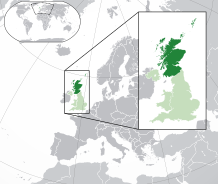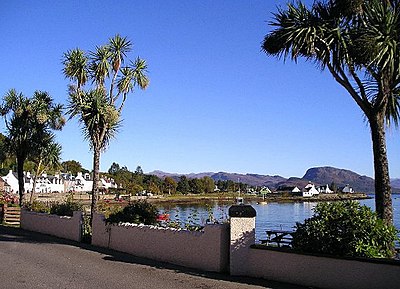| Main Page | Selected articles 1 | Selected articles 2 | Selected biographies | Selected quotes | Selected pictures | Featured Content | Categories & Topics |
Introduction
 |

|
|

| ||
Scotland (Scots: Scotland; Scottish Gaelic: Alba) is a country that is part of the United Kingdom. It contains nearly one-third of the United Kingdom's land area, consisting of the northern part of the island of Great Britain and more than 790 adjacent islands, principally in the archipelagos of the Hebrides and the Northern Isles. To the south-east, Scotland has its only land border, which is 96 miles (154 km) long and shared with England; the country is surrounded by the Atlantic Ocean to the north and west, the North Sea to the north-east and east, and the Irish Sea to the south. The population in 2022 was 5,439,842. Edinburgh is the capital and Glasgow is the largest of the cities of Scotland.
The Kingdom of Scotland emerged as an independent sovereign state in the 9th century. In 1603, James VI succeeded to the thrones of England and Ireland, forming a personal union of the three kingdoms. On 1 May 1707, Scotland and England combined to create the new Kingdom of Great Britain, with the Parliament of Scotland subsumed into the Parliament of Great Britain. In 1999 a Scottish Parliament was re-established, and has devolved authority over many areas of domestic policy. The country has its own distinct legal system, education system and religious history, which have all contributed to the continuation of Scottish culture and national identity. Scottish English and Scots are the most widely spoken languages in the country, existing on a dialect continuum with each other. Scottish Gaelic speakers can be found all over Scotland, however the language is largely spoken natively by communities within the Hebrides. The number of Gaelic speakers numbers less than 2% of the total population, though state-sponsored revitalisation attempts have led to a growing community of second language speakers.
The mainland of Scotland is broadly divided into three regions: the Highlands, a mountainous region in the north and north-west; the Lowlands, a flatter plain across the centre of the country; and the Southern Uplands, a hilly region along the southern border. The Highlands are the most mountainous region of the British Isles and contain its highest peak, Ben Nevis, at 4,413 feet (1,345 m). The region also contains many lakes, called lochs; the term is also applied to the many saltwater inlets along the country's deeply indented western coastline. The geography of the many islands is varied. Some, such as Mull and Skye, are noted for their mountainous terrain, while the likes of Tiree and Coll are much flatter. (Full article...)
Selected article

The Jacobite rising of 1745 was an attempt by Charles Edward Stuart to regain the British throne for his father, James Francis Edward Stuart. It took place during the War of the Austrian Succession, when the bulk of the British Army was fighting in mainland Europe, and proved to be the last in a series of revolts that began in March 1689, with major outbreaks in 1715 and 1719.
Charles launched the rebellion on 19 August 1745 at Glenfinnan in the Scottish Highlands, capturing Edinburgh and winning the Battle of Prestonpans in September. At a council in October, the Scots agreed to invade England after Charles assured them of substantial support from English Jacobites and a simultaneous French landing in Southern England. On that basis, the Jacobite army entered England in early November, but neither of these assurances proved accurate. On reaching Derby on 4 December, they halted to discuss future strategy.
Similar discussions had taken place at Carlisle, Preston and Manchester and many felt they had gone too far already. The invasion route had been selected to cross areas considered strongly Jacobite in sympathy, but the promised English support failed to materialise. With several government armies marching on their position, they were outnumbered and in danger of being cut off. The decision to retreat was supported by the vast majority, but caused an irretrievable split between Charles and his Scots supporters. Despite victory at Falkirk Muir in January 1746, defeat at Culloden in April ended the rebellion. Charles escaped to France, but was unable to win support for another attempt, and died in Rome in 1788. (Full article...) Read more ...
Selected quotes
" ... You talked of Scotland as a lost cause and that is not true. Scotland is an unwon cause ... "
— John Steinbeck, in a letter to Mrs John F. Kennedy
" ... We live in a moment of history where change is so speeded up that we begin to see the present only when it is already disappearing ... "
In the news

- 17 September 2024 – 2026 Commonwealth Games
- Glasgow, Scotland, is formally selected as the host city of the 2026 Commonwealth Games. (BBC News)
- 19 August 2024 –
- A rocket engine for Rocket Factory Augsburg's launch vehicle RFA One explodes during a test launch at the SaxaVord Spaceport in Scotland, United Kingdom. (BBC News)
Selected biography

Sir John Young "Jackie" Stewart OBE (born 11 June 1939) is a British former racing driver, broadcaster and motorsport executive from Scotland, who competed in Formula One from 1965 to 1973. Nicknamed "The Flying Scot", Stewart won three Formula One World Drivers' Championship titles and—at the time of his retirement—held the records for most wins (27), and podium finishes (43).
Amongst his three titles, Stewart twice finished as runner-up over his nine seasons in Formula One. He was the only British driver with three championships until Lewis Hamilton equalled him in 2015. Outside of Formula One, he narrowly missed out on a win at his first attempt at the Indianapolis 500 in 1966 and competed in the Can-Am series in 1970 and 1971. Between 1997 and 1999, in partnership with his son, Paul, he was team principal of the Stewart Grand Prix F1 racing team. After retiring from racing, Stewart was an ABC network television sports commentator for both auto racing, covering the Indianapolis 500 for over a decade, and for several summer Olympics covering many events, being a distinctive presence with his pronounced Scottish accent. Stewart also served as a television commercial spokesman for both the Ford Motor Company and Heineken beer.
Stewart was instrumental in improving the safety of motor racing, campaigning for better medical facilities and track improvements at motor racing circuits. After John Surtees' death in 2017, he is the last surviving Formula One World Champion from the 1960s. He is also the oldest living Grand Prix winner.
Selected picture
Plockton (Scottish Gaelic: Am Ploc/Ploc Loch Aillse) is a picturesque settlement in the Highlands on the shores of Loch Carron. It faces east, away from the prevailing winds, which together with the North Atlantic Drift, gives it a mild climate, allowing palm trees (actually cabbage trees) to grow.
Photo credit: Arthur Bruce
Did You Know...

- ... that William of Littlington opposed the division of England and Scotland into two Carmelite provinces in 1303, was excommunicated, and did four years' penance in Paris?
- ... that Helen Steven shared the Gandhi International Peace Award for her opposition to the nuclear submarine base in Scotland?
- ... that East Suffolk Park, a former student hostel in Edinburgh, was once an internment camp for enemy aliens?
- ... that the uncommon Florida lichen species Gyalectidium yahriae was named after Rebecca Yahr of the Royal Botanic Garden Edinburgh in Scotland?
- ... that Prince Philip was the first member of the British royal family to fly in a helicopter?
- ... that the Springburn Winter Gardens, the largest single-span glasshouse in Scotland, has been derelict since 1983?
- ... that visitors to Balmaclellan in Scotland can stay in a historic watermill that is "remarkable" for the preservation of its internal workings?
- ... that Scottish nurse Euphemia Steele Innes was decorated with the Royal Red Cross first class for services with the Territorial Force Nursing Service in World War I?
Get involved
For editor resources and to collaborate with other editors on improving Wikipedia's Scotland-related articles, see WikiProject Scotland.
To get involved in helping to improve Wikipedia's Scotland related content, please consider doing some of the following tasks or joining one or more of the associated Wikiprojects:
- Visit the Scottish Wikipedians' notice board and help to write new Scotland-related articles, and expand and improve existing ones.
- Visit Wikipedia:WikiProject Scotland/Assessment, and help out by assessing unrated Scottish articles.
- Add the Project Banner to Scottish articles around Wikipedia.
- Participate in WikiProject Scotland's Peer Review, including responding to PR requests and nominating Scottish articles.
- Help nominate and select new content for the Scotland portal.
Do you have a question about The Scotland Portal that you can't find the answer to?
Post a question on the Talk Page or consider asking it at the Wikipedia reference desk.
Related portals
Other language versions
Associated Wikimedia
The following Wikimedia Foundation sister projects provide more on this subject:
-
Commons
Free media repository -
Wikibooks
Free textbooks and manuals -
Wikidata
Free knowledge base -
Wikinews
Free-content news -
Wikiquote
Collection of quotations -
Wikisource
Free-content library -
Wikispecies
Directory of species -
Wikiversity
Free learning tools -
Wikivoyage
Free travel guide -
Wiktionary
Dictionary and thesaurus






































